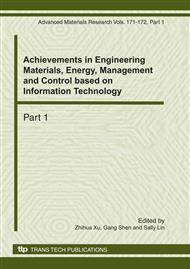[1]
L.A. Zadeh, Fuzzy Sets, Inform and Control 8 (1965) 338-353.
Google Scholar
[2]
L.A. Zadeh, The concept of a linguistic variable and its application to approximate reasoning Ⅰ, Information. Sci. 8 (1975) 199-249.
DOI: 10.1016/0020-0255(75)90036-5
Google Scholar
[3]
Q. Song and B.S. Chissom, Fuzzy time series and its models, Fuzzy Sets and Systems, 54 (1993) 269-277.
DOI: 10.1016/0165-0114(93)90372-o
Google Scholar
[4]
Q. Song and B.S. Chissom, Forecasting enrollments with fuzzy time series – Part Ⅰ, Fuzzy sets and systems, 54 (1993) 1-10.
DOI: 10.1016/0165-0114(93)90355-l
Google Scholar
[5]
B. Abraham, Ledolter J., Statistical Methods for Forecasting, John Wiley and Sons, (1983).
Google Scholar
[6]
A. Bardossy, I. Bogardi and L. Duckstein, Fuzzy regression in hydrology, Water Resources Research, 26(1990) 1497-1508.
DOI: 10.1029/wr026i007p01497
Google Scholar
[7]
P.T. Chang, Fuzzy seasonality forecasting, Fuzzy sets and systems, 90 (1997) 1-10.
DOI: 10.1016/s0165-0114(96)00138-8
Google Scholar
[8]
S.M. Chen, Forecasting enrollments based on fuzzy time series, Fuzzy sets and systems, 81 (1996) 311-319.
DOI: 10.1016/0165-0114(95)00220-0
Google Scholar
[9]
De Luca, A., Termini, S. A definition of a nonprobabilistic entropy in the setting of fuzzy set theory, Inf. and Control, 20 (1972).
DOI: 10.1016/s0019-9958(72)90199-4
Google Scholar
[10]
J.R. Hwang, S.M. Chen and C.H. Lee, Handling forecasting problems using fuzzy time series, Fuzzy sets and systems, 100 (1998) 217-228.
DOI: 10.1016/s0165-0114(97)00121-8
Google Scholar
[11]
C. T. Lee, A Method for Fuzzy Time Series, Master Thesis, Department of Industrial Engineering, National Tsing Hua University, (1996).
Google Scholar
[12]
E.H. Mamdani, Application of fuzzy logic to approximate reasoning using linguistic synthesis, IEEE Trans. Comput. 26 (1977) 1182-1191.
DOI: 10.1109/tc.1977.1674779
Google Scholar
[13]
A. Pankratz, Forecasting with Dynamic Regression Models, John Wiley and Sons, (1991).
Google Scholar
[14]
Q. Song and B. S Chissom, Forecasting enrollments with fuzzy time series – Part Ⅱ, Fuzzy sets and systems, 62 (1994) 1-8.
DOI: 10.1016/0165-0114(94)90067-1
Google Scholar
[15]
H. Tanaka and S. Uejima and K. Asai, Fuzzy linear model, Fuzzy linear regression model, IEEE Trans. System, Man and Cybernet, 12 (1982) 903-907.
DOI: 10.1109/tsmc.1982.4308925
Google Scholar
[16]
H. F. Wang and R. C. Tsaur, Resolution of fuzzy regression model, To appear at European J. of O.R. Vol. 126(3), (2000).
Google Scholar


